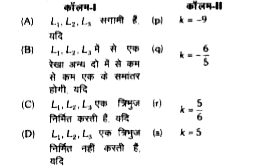यदि Dr=∣∣ ∣ ∣∣2r−12.3r−14.5r−1xyz2n−13n−15n−1∣∣ ∣ ∣∣ तो n∑i=1Dr का मान है
1
−1
0
इनमे से कोई नहीं
The correct Answer is:C
Step by step video, text & image solution for यदि D_(r)=|{:(2^(r-1),2.3^(r-1),4.5^(r-1)),(x,y,z),(2^(n)-1,3^(n)-1,5^(n)-1):}| तो sum_(i=1)^(n)D_(r) का मान है by Maths experts to help you in doubts & scoring excellent marks in Class 12 exams.
Updated on:21/07/2023Topper's Solved these Questions
- सारणिक तथा आव्यूह BOOK - ERRORLESS HINDICHAPTER - सारणिक तथा आव्यूह EXERCISE - Solved Multiple Choice Questions (सारणिक का प्रसार , सारणिक के रूप में समीकरण का हल एवं सारणिक के गुणधर्म)
150 Videos
- सारणिक तथा आव्यूह BOOK - ERRORLESS HINDICHAPTER - सारणिक तथा आव्यूह EXERCISE - Solved Multiple Choice Questions ( रैखिक समीकरणों का निकाय कुछ विशेष सारणिक, सारणिक का अवकलन तथा समाकलन)
50 Videos
- सरल रेखा BOOK - ERRORLESS HINDICHAPTER - सरल रेखा EXERCISE - JEE ADVANCE (Matrix Match type questions)
4 Videos
Similar Questions
∣∣ ∣ ∣∣1aa2−bc1bb2−ac1cc2−ab∣∣ ∣ ∣∣=
View Solutiona का वह मान जिसके लिये समीकरण निकाय a3x+(a+1)3y+(a+2)3z=0,ax(a+1)y+(a+2)z=0,x+y+z=0 का एक अशून्य हल है
View Solution
View SolutionIf Δr=∣∣ ∣ ∣∣2r−12.3r−14.5r−1αβγ2n−13n−15n−1∣∣ ∣ ∣∣ , then find the value of Δ
View SolutionIf sum_(r=1)^(n)I(r)=2^(n)-1 then sum_(r=1)^(n)(1)/(I_(r)) is
View SolutionThe value of lim_(n rarr oo)(1*sum_(r=1)^(n)(r)+2*sum_(r=1)^(n-1)(r)+3sum_(r=1)^(n-2)(r)+....+n.1)/(n^(4))
View SolutionIf Dr=∣∣ ∣ ∣∣r1n(n+1)22r−14n22r−152n−1∣∣ ∣ ∣∣, then the value of n∑r=1Dr, is
View SolutionStatement-1: n∑r=0(r+1)nCr=(n+2)2n−1
Statement -2: n∑r=0(r+1)nCrxr=(1+x)n+nx(1+x)n−1
View SolutionStatement -2: n∑r=0(−1)rnCrr+1=1n+1
Statement-2: n∑r=0(−1)rnCrr+1xr=1(n+1)x{1−(1−x)n+1}
View Solutionn∑r=1r2−n∑r=1n∑r=1 is equal to
View SolutionIf Dr=∣∣ ∣ ∣∣rxn(n+1)/22r−1yn23r−1zn(3n+1)/2∣∣ ∣ ∣∣ then n∑r=1Dr=
View SolutionIf D_(r)=|(2^(r-1),2(3^(r-1)),4(5^(4-1))),(x,y,z),(2^(n)-1,3^(n)-1,5^(n)-1)| then sum_(r=1)^(n)D_(r)=
View Solutionकथन-1 : n∑r=0(r+1).nCr=(n+2)2n−1
कथन-2 : n∑r=0(r+1).nCrxr=(1+x)n+nx(1+x)n−1
View Solutionयदि Dr=∣∣ ∣ ∣∣2r−13r−14r−1xyz2n−1(3n−1)/2(4n−1)/3∣∣ ∣ ∣∣ तब nΣr=1Dr का मान है
View Solutionकथन-1 : n∑r=0(r+1).nCr=(n+2)2n−1
कथन-2 : n∑r=0(r+1).nCrxr=(1+x)n+nx(1+x)n−1
View Solution
